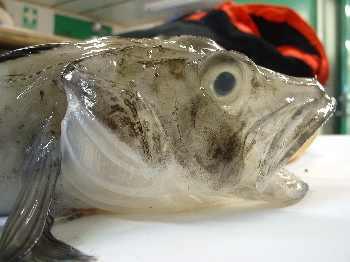12 February, 2004
After breaking the dredge yesterday, we were looking forward to a
calm quite day of catching up with the multibeam survey. Throughout
the cruise we have been at the mercy of the ice as to where we would
be able to get survey data. Just about midnight, the ship moved into
an area that had been previously too congested with ice to do good
multibeam work. Today it was clear, so we went looking for seamounts.
What a surprise. As the ship made its back and forth tracks over the
seafloor, a map of orange and yellow began to emerge on the monitors.
We saw large circular structures randomly dotting an otherwise flat
and uninteresting seafloor. At first glance, these looked like the
bases of volcanoes that had the top of their cones completely sliced
off. As the data continued to come in, it became apparent that the
circles were not elevations on the seafloor, but circular depressions
in the seafloor. It was time for speculation and hypotheses about
their origin. We called this new area the Pepperoni formations.
Even though the ice had cleared, there was plenty of ice in the air.
Snow settled on the decks of the ship adding just enough white to
stir thoughts of snowball fights and snowmen. The snow blanketed most
of the decks, except for the back deck that is the main work area for
the ship. The back deck uses warmed antifreeze circulating in pipes
under the deck to keep is and snow from accumulating. This helps keep
everyone safe when working with equipment in the back deck.
Most of the morning was spent surveying the "Pepperoni" and then
about noon we headed north toward Franklin Island. By 1:30 PM we had
the dredge back in the water for the first of two dredges for the
day. Each time we dredge we hope to bring up rocks that will give us
information about the age and composition of the seafloor volcanoes
that are focus of our dredge work.
The dredge came on deck intact and full of rocks. Jesse Doran
positioned the dredge the over the work area on the back deck and
reached into the top of the dredge and pulled out an ice fish over a
foot long. Its mouth was open, with large round eyes, white gills and
thing black body. He passed the catch of the day to me, and I held it
as everyone took a look before heading to separate out the rocks from
the debris.
As I held the fish, it moved slightly. I took it into the hydro lab
and placed it into one of the sinks and filled it with seawater.
Within seconds the gills were moving rhythmically, and then the fish
began to slowly swim around the sink. Half of the people on the ship
never see what is caught in the dredge because they are sleeping or
nature of their work does not permit them to leave during their
shift. Jenny White was able to locate a large glass aquarium and
filled it with seawater. We placed the organisms that had been caught
in the dredge in there for the night. In addition to the fish we had
two large sponges and a starfish that was about seven inches from arm
to arm. During the course of the night everyone was able to come and
see the aquarium.
Over the course of the night, many small organisms moved out of
hiding among the spicules of the sponges. There were worms, sea
spiders, small snails that slowly moved out into the open. There were
over a hundred small organisms that were calling these sponges home
that we could see. The sponges were like a small forest that these
tiny organisms lived in.
We continued the multibeam survey throughout most of the evening. The
marine techs finished getting the guns ready for a possible
deployment of the seismic sometime tomorrow.
Who's Who.
Mike Carpenter - Raytheon - Electronics Tech - Hometown: Reepsville,
NC Presently live in: Danville, CA
Education: BS Electrical Engineering, NC State University Work
history: 15 years, broad experience in industry and government
Dean Klein - Raytheon - IT Computer Services - Ten years with
Antarctic programs. Second Cruise on Palmer. He has worked at
McMurdo, Palmer and South Pole Stations. He has a degree from the
University of Georgia in education. He began working in Antarctica
with black hair and now has gray. He is fascinated with the research
and science that goes on here and considers Antarctica to be the
canary in the coalmine for the world
He is married and has two chocolate labs. The brown bombers don't
even know how to chase balls yet. His wife is studying to be a
physician's assistant and is involved in a number of volunteer groups
in Ashville, North Carolina. He got involved in computers working
with the forest service and then worked into the IT field when he had
been working on a recreational use study in the US. The reason that
he is here in Antarctica is because he had worked with a person that
had actually signed the Antarctic Treaty.

Snow accumulates on the upper decks.

Ice fish caught in the dredge.

Contact the TEA in the field at
.
If you cannot connect through your browser, copy the
TEA's e-mail address in the "To:" line of
your favorite e-mail package.
|
